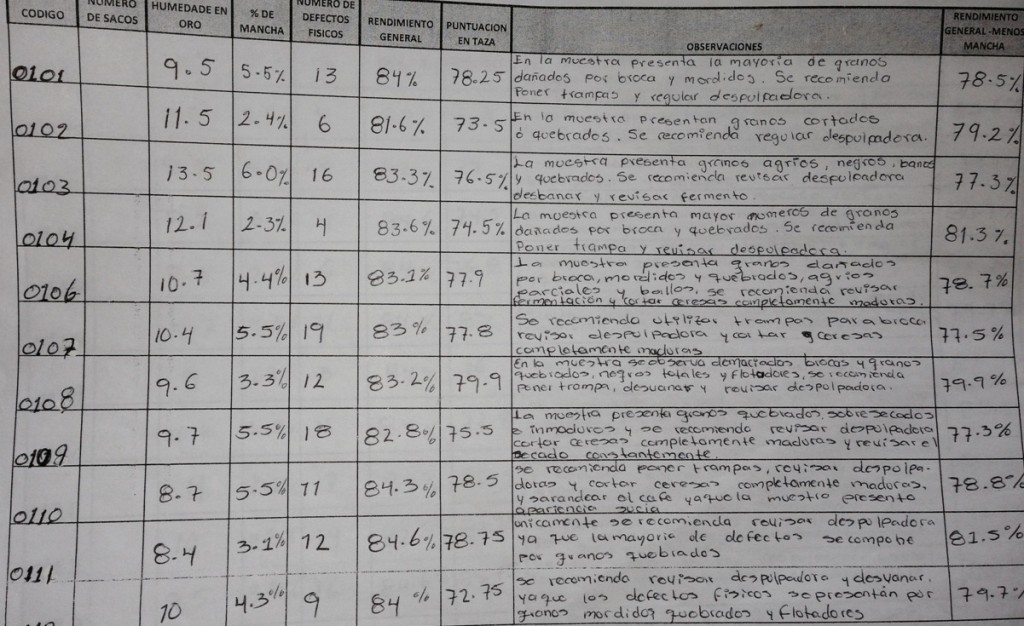This post is a featured comment submitted in response to my recent post on the farm-facing cupping form.
It combines comments by three people: TJ Semanchin and Caleb Nicholes of Kickapoo Coffee in Viroqua, WI and Mark Glenn of Conscious Coffees in Boulder, CO.
Both roasters are recent winners of the Roast Magazine Microroaster-of-the-Year award. Both roasters are also members of Cooperative Coffees, an innovative importing cooperative comprised of 25 roasters throughout the United States and Canada that sources directly from dozens of smallholder organizations around the world.
TJ, Caleb and Mark agree that more can and should be done to link sensory evaluation in the lab to what happens on the farm and at the mill.
They also agree that this process should be centered as close to the farm as possible.
TJ offers some photographic evidence that it is already happening in some places in the coffeelands.
And Caleb reminds us that quality isn’t free–once we get the recommendations right, growers need financial incentives to implement them.
- Move farm-facing cupping closer to the farm.
I feel that we as cuppers can certainly taste it when a coffee is harvested and processed perfectly or imperfectly, but to rely on feedback from that sensory analysis for accurate recommendations to famers in the field is too difficult and imperfect to implement.
–TJ Semanchin,
Kickapoo Coffee
There are really very few cuppers who are educated enough with processing conditions to make good, solid and safe recommendations. The ones MOST qualified to use a farm-facing cupping form are the farmers themselves. They are the ones directly tied to processing techniques that can make or break a coffee on the cupping table. They might need some initial education about how processing techniques can affect the cup and longevity of a coffee but after that, they can take the reins assuming they have the ability and infrastructure to taste and cup.
–Caleb Nicholes,
Kickapoo Coffee
I think it is risky for us cuppers to include prescriptive notes on a form, based on our sensory analysis. I find there are more cuppers than ever who seem to “have the answers” and I fear that the growers can be easily misled. There are countless intervening variables that account for the quality of a cup, and the one who actually prescribes should be very qualified.
–Mark Glenn,
Conscious Coffees
- The form is just a form. It’s the PROCESS that matters.
What I feel is the best path forward is to work with and support internal capacity within cooperatives that are able to assess and evaluate quality throughout the post harvest handling chain. This is already emerging as a best practice in the field, as the photo above attests.
I propose to de-emphasize cupping reports (still a crucial analysis tool) and promote quality evaluation starting at the point of delivery of parchment from farmers to the cooperative’s bodega. Inspection of the quality and humidity of the parchment is already and certianly should be the norm for a co-op, what is often lacking is the recording of data from this analysis, and the subsequent feedback to the producer after the harvest. Included with this initial data should expected yield of parchment to export quality green coffee, the results of the visual green evaluation (e.g., number of defect), the roasted evaluation (e.g., number of quakers), and finally the sensory evaluation of the cupping report with emphasis on faults resulting from processing errors. Recomendations to individual farmers can then be offered based on all this data. Also, from this comprehensive evaluation the co-op can track progress with a specific farmer from year to year and perhaps reward that progress with quality incentives (with the caveat this is culturally inappropriate for certain farmer groups). Another benefit with this approach is that with best quality practice recommendations to individual farmers, there is a mechanism in place that could also offer recommendations for increased yields and other cost saving, or profit increasing, methods.
–TJ
- Show. Me. The Money.
I hear a lot of talk about improving quality but I find that the reality for most organizations is that they have a tough time getting remunerated for the work it takes to improve quality. There are certain differentials for every country and it is really difficult for producers to bust out of those realities, no matter how good your coffee is. Before changes are made, it is important to know what the costs will be, both to the farmers in terms of their time and risk, as well as if it is worth it to make such changes. If a farmer needs to expend 25% more effort to increase quality 2 points, they need to find a buyer willing to pay that. For a two-dollar FOB coffee, that’s 50 cents and most buyers I know can’t justify it.
–Caleb



